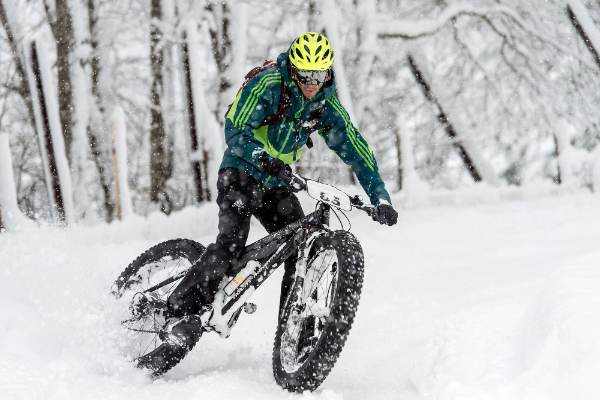Winter mountain biking is an exhilarating experience, but it requires careful preparation, especially in terms of clothing. The cold, wind, and moisture can significantly impact your comfort and safety. Understanding how to dress appropriately will help you enjoy the ride while staying warm and dry.
Layering: The Fundamental Principle
The key to dressing for winter mountain biking is layering. Layering allows you to adjust your clothing based on your activity level and the weather conditions. There are three main layers to consider: the base layer, the mid-layer, and the outer layer.
Base Layer: Moisture Management
The base layer is the first layer of clothing next to your skin. Its primary function is to wick moisture away from your body to keep you dry. When you sweat, moisture can cool you down quickly in cold weather, so this layer is crucial.
- Materials: Look for base layers made from synthetic fabrics like polyester or natural fibers like merino wool. Avoid cotton as it retains moisture.
- Fit: The base layer should fit snugly against your skin without being too tight.
Mid-Layer: Insulation
The mid-layer provides insulation to keep you warm. This layer traps body heat and provides a barrier against the cold.
- Materials: Fleece, down, or synthetic insulated jackets work well for this layer.
- Fit: The mid-layer should be comfortably loose to allow for layering underneath but not so loose that it hinders movement.
See Also: Is Mountaineering a Sport
Outer Layer: Protection from the Elements
The outer layer, also known as the shell layer, protects you from wind, rain, and snow. This layer should be waterproof and windproof while allowing moisture to escape.
- Materials: Look for jackets and pants made from Gore-Tex or other waterproof, breathable fabrics.
- Fit: The outer layer should fit comfortably over your other layers without being too tight or restrictive.
Head and Face Protection
Your head and face are particularly vulnerable to cold weather. Proper protection in these areas is essential.
- Helmet: A well-ventilated helmet is essential. In winter, use a helmet cover to block wind and retain heat.
- Balaclava or Skull Cap: A balaclava can cover your head, face, and neck, providing warmth and protection from wind. A skull cap can fit under your helmet for added warmth.
- Goggles or Glasses: Protect your eyes from wind, snow, and glare with cycling-specific goggles or glasses.
Hand Protection
Cold hands can quickly ruin a ride. Proper gloves are essential for warmth and dexterity.
- Glove Liners: Thin, moisture-wicking liners can be worn under heavier gloves for added warmth.
- Winter Cycling Gloves: Look for insulated, windproof, and waterproof gloves designed for cycling.
- Bar Mitts: These are handlebar-mounted mitts that provide an additional layer of protection and warmth for your hands.
Foot Protection
Cold, wet feet are uncomfortable and can lead to frostbite in extreme conditions. Proper footwear is crucial.
- Socks: Wear moisture-wicking socks made from wool or synthetic materials. Avoid cotton.
- Winter Cycling Shoes: These are insulated and waterproof, designed specifically for cold weather riding.
- Toe Covers or Shoe Covers: Add an extra layer of protection against wind and moisture with toe covers or full shoe covers.
Additional Tips for Winter Mountain Biking Clothing
- Plan for Temperature Changes: Winter weather can be unpredictable. Be prepared to add or remove layers as needed.
- Carry Extra Clothing: Pack an extra pair of gloves, socks, and a hat in case your primary items get wet.
- Avoid Overheating: Dress in layers and remove them as needed to avoid sweating, which can lead to chills.
- Stay Dry: Choose clothing with moisture-wicking properties to keep sweat away from your skin.
- Visibility: Shorter days and low light conditions mean visibility is crucial. Wear bright colors and reflective gear to stay visible.
Conclusion
Winter mountain biking can be a fantastic experience if you’re properly dressed for the conditions. By following these guidelines and choosing the right clothing, you can stay warm, dry, and comfortable on your rides. Remember to prioritize layering, protect your extremities, and be prepared for changing weather conditions. Happy riding!
FAQ: How to Dress for Winter Mountain Biking
Q: What should I wear on the top half of my body?
A: For the upper body, it’s important to layer your clothing. Start with a moisture-wicking base layer, followed by an insulating middle layer like a fleece or wool sweater. If it’s very cold, add a windproof and waterproof outer layer.
Q: What about my legs?
A: Wear waterproof pants or tights over your base layer leggings. Some riders prefer baggy pants with knee pads for extra protection. Make sure your pants are long enough to tuck into your socks to prevent snow from getting in.
Q: How do I keep my feet warm?
A: Invest in a good pair of waterproof winter boots with insulation. Wear thick wool socks and consider neoprene booties for extra warmth. Avoid cotton socks as they absorb moisture and can make your feet cold.
Q: What kind of gloves should I wear?
A: Choose waterproof and insulated gloves that are also breathable. Some riders prefer mittens for extra warmth, but make sure they allow for dexterity when shifting gears.
Q: How can I protect my head and face?
A: Wear a helmet cover to keep your head warm and dry. A neck gaiter or balaclava can protect your face and neck from the cold wind. Make sure your goggles are fog-resistant and provide UV protection.
Q: Any tips for staying dry?
A: Yes, it’s crucial to stay dry to avoid hypothermia. Wear waterproof layers and avoid cotton as it retains moisture. Bring a spare set of clothes in case you get wet, and change into them if necessary.
Q: What about accessories?
A: Don’t forget to bring hand warmers, a thermos with hot drinks, and energy bars or snacks. A hydration pack with an insulated hose is also useful for staying hydrated without freezing your water supply.

